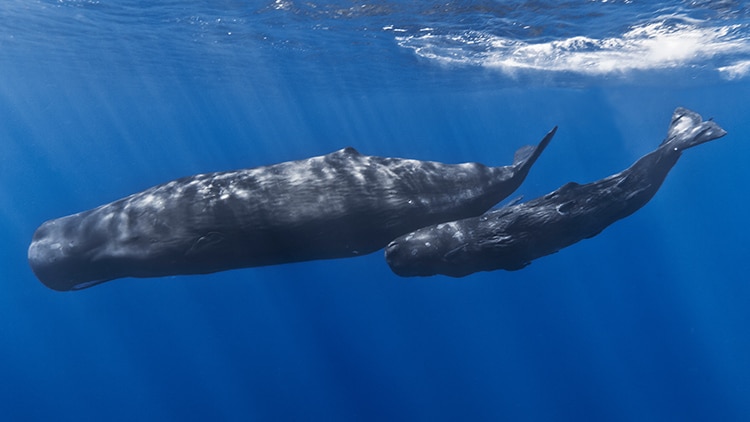
Sperm whales swim near Mauritius. (Photo: Gabriel Barathieu via Wikimedia Commons, CC BY-SA 2.0 DEED)
Sperm whales are fascinating creatures. Endangered and still recovering from being hunted by whalers in the 19th century, sperm whales were long targets for their spermaceti, which, according to NOAA, is “an oil sac that helps the whales focus sound.” While this oil was a commercial product to humans, to the whales, it assists communication among pods of whales that live in different regions. By studying about 60 whales in the Eastern Caribbean clan, researchers have announced in a new study that sperm whales use a complex system of clicks or coda which overlap, rise, fall, and more in a phonetic alphabet of sorts, possibly on par with the complexity of human language.
Sperm whales communicate for feeding, breeding, and other social needs. To do so, they vocalize a series of clicking noises that pass as sound through the water. A combination of clicks is a coda, but these codas seem to function like an alphabet of sounds that can be altered and combined.
“Investigating a dataset collected across over a decade of nearly 9,000 codas from the sperm whale families of the Eastern Caribbean clan, our results show that these whales have a more complex combinatorial communication system that demonstrates rubato and ornamentation, in which whales make sub-second adjustments to match one another as they converse and add extra clicks to known coda types depending on the context within their conversations,” shares Dr. Shane Gero, of Project CETI and the Dominica Sperm Whale Project.
The whales alter their coda by adding or subtracting clicks (ornamentation), drawing out the spacing (rubato), or responding in the moment to another's “speech.” The layering and social responses may be indicative of meaning, but so far, the researchers have just classified the sounds to survey the base of the “language” they will then seek to decode. Future investigation will also be needed to compare coda across clans, as geographically specific groups can have their own dialects.
“Understanding structure is the first step, the next would be to combine this with an understanding of context, both behavior (what they are doing when we find ornaments, for example) and social context (who they are with when rubato varies the most? Is it with mom-calf, or two sisters, or correlated with kin relatedness, for example),” Dr. Gero adds.
Certainly, this adds one more item to the list of special facts about sperm whales that make them the fascinating giants of the ocean.
A new study reveals that sperm whale vocalizations, known as codas, demonstrate complexity and flexibility unseen outside of human language.

Photo: VITALIY_SOKOL/Depositphotos
h/t: [IFL Science]
Related Articles:
Arctic Researchers Get Surprised by Polar Bear Visitors While Making Breakfast
New Evidence Suggests Bioluminescence Has Been Present in Animals for at Least 540 Million Years
Ancient Burial Site Reveals Foxes May Have Been Human‘s Best Friend Before Dogs
These Orangutan Videos Show off How Smart the Critically Endangered Primates Are






















































































